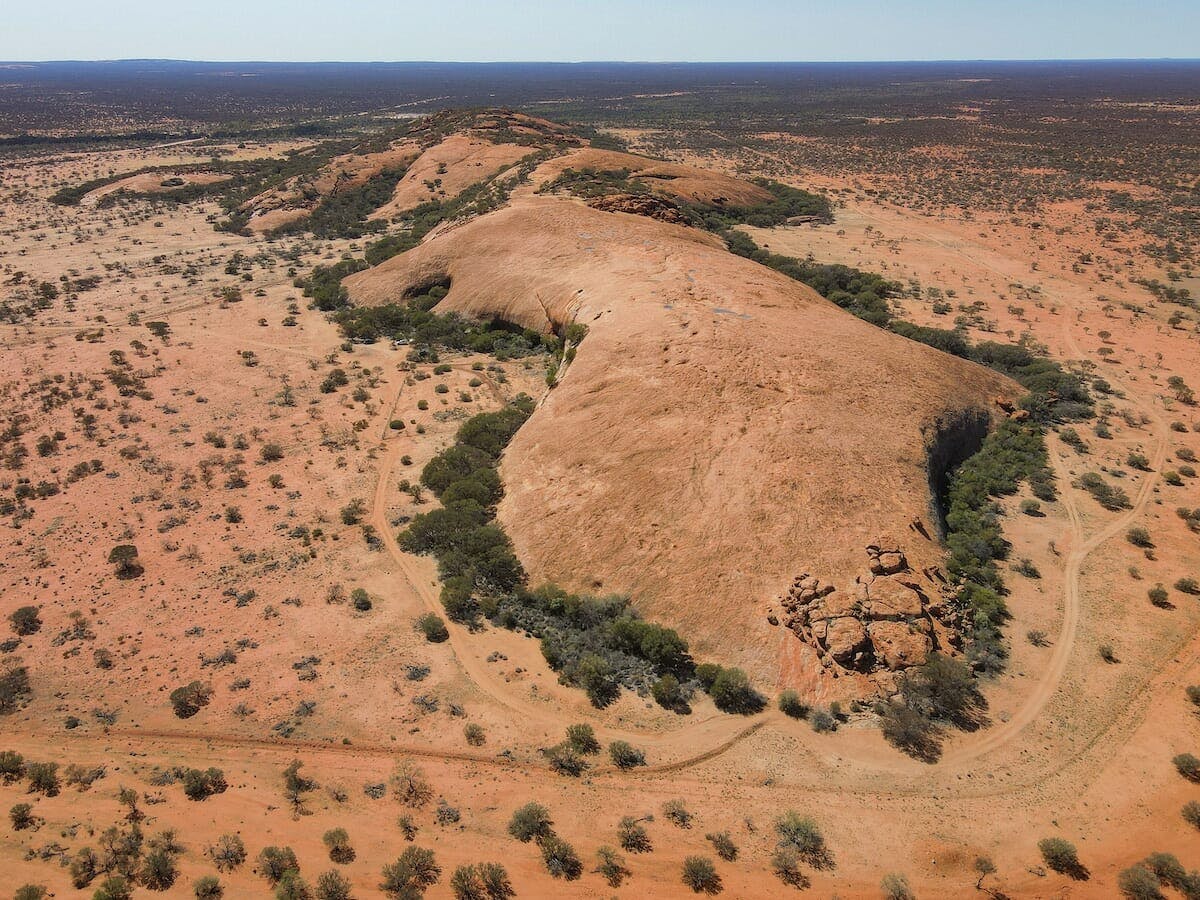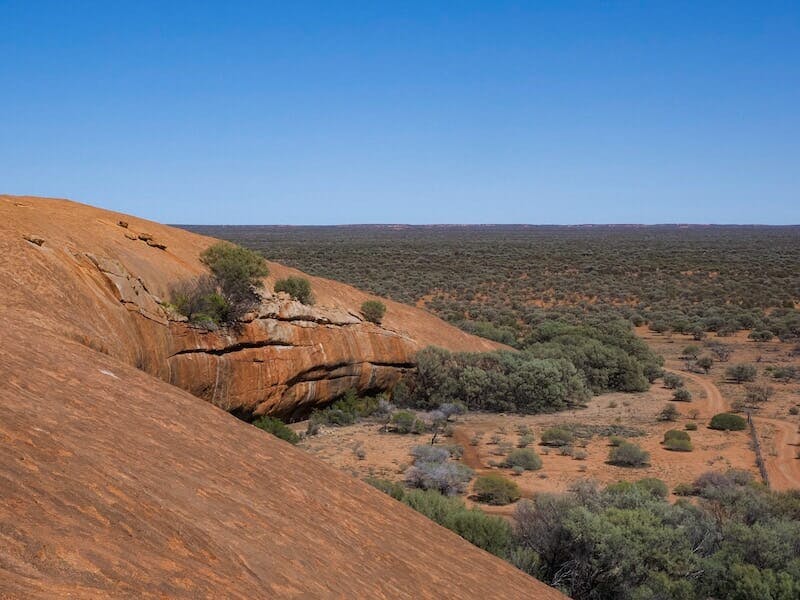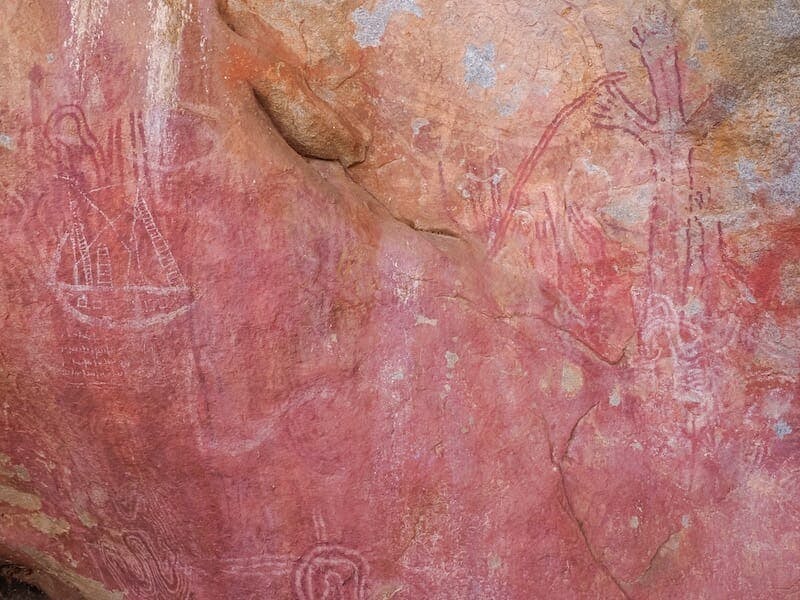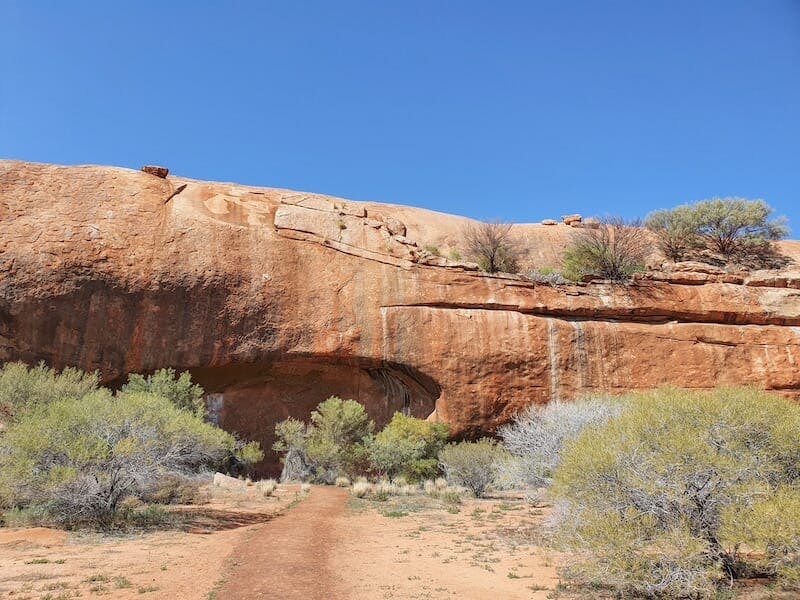Walga Rock: Everything you need to know

The Western Australian outback is home to many secrets and mysteries, but one big one is Walga Rock.
Words and photos by Cassie Wilkins.
The second-biggest monolith in the country after Uluru, this mega monzogranite is not only of epic proportions, it’s also 2.6 billion years old and is home to WA’s largest Aboriginal rock art gallery – which features a mysterious motif that has puzzled experts and visitors alike for generations. And, chances are, it hasn’t even crossed your radar… yet.
So, without further ado, let’s delve right in! Here’s everything you need to know about Walga Rock.

What is it?
Rising up from the red dirt in (what feels like) the middle of the outback, Walga Rock is a giant granite monolith and a sacred place to the Wajarri people, who used a natural cave under the rock for shelter – and for art – for over 10,000 years.
In fact, this cave has now been recognised as the largest outdoor Aboriginal rock art collection in Western Australia, with nearly a thousand Wajarri motifs, including handprints and depictions of animals and Dreamtime stories. However, there’s one painting in particular that has captivated people’s imaginations for the last century: a white sailing ship, with several lines of what could be Arabic text underneath it – though others believe it could just be scribbles depicting the ocean.
Drawn in a different style to the rest of the artwork and 350 km from the nearest coast, it’s no wonder that this mystery – which was first officially reported in the Geraldton Guardian in 1928 – has transfixed visitors for nearly a century. Even today, there are a few different theories, though they vary even over the type of ship it could be, from a couple of different 17th-century VOC (Dutch East India Company) ships to the 19th-century steamer SS Xantho, which sank off the coast of Port Gregory in 1872.
While we could talk outback mystery theories all day, the most popular theory – which is also shared by the experts at the WA Shipwreck Museum – is that the painting does indeed depict SS Xantho, and it could have been drawn by a man known as Sammy “Malay”, AKA Sammy Hassan, an indentured labourer who was potentially transported to WA from Southeast Asia and ended up camped with the Wajarri people at Walga Rock.
However, rumours abound that said Sammy may have been the victim of a shark attack at Shark Bay and so it couldn’t possibly have been him, it must have been other shipwrecked and abandoned sailors… Or perhaps an Afghan cameleer or a Wajarri person who went to the coast and saw the ship and then returned to Walga Rock. But with even the lines underneath remaining indecipherable and indeed indistinguishable to this day, the true origins of the mysterious ship may never come to light.
Other than the cave – which is the main attraction, of course – Walga Rock itself is pretty impressive, with balancing boulders, gnamma holes (rock pools), and even trees growing out of crevices atop the rock. In spring, wildflowers grow all around the base of the rock (and even sometimes on top of it) making this amazing place even cooler.

Where is it?
It’s pretty ridiculous to think that a rock of this size could be hiding in plain sight, but that’s exactly what it’s doing. Found down a labyrinthine dirt road, about 7.5 hours north of Perth, 40 minutes east of Cue and/or 160 km north of Yalgoo, the entrance sign for Walga Rock does not do this amazing place any justice – and at times, has even gone missing entirely. Still, while you might drive right past and have to backtrack to find it, this is a place where the journey is part of the adventure, so don’t give up hope – this juice is definitely worth the squeeze.
To get to the rock itself, you’ll have to drive through a gate (don’t forget to close it behind you when you enter and when you leave!), then follow the road and park up under the trees, before taking the well-trodden path out to the overhanging cave and the rock art. The unsealed roads out there are usually 2WD accessible, but you’ll have to double check after heavy rains. Call the Visitor Centre at Mount Magnet or Cue to ask if you’re unsure.

Where to stay
These days camping at the rock is strictly prohibited, so you’ll have to seek shelter elsewhere. If you’re looking for a hearty feed and a comfy bed or a caravan park with all the fancy amenities, Cue, Yalgoo or Mount Magnet might be your best bet, though there are station stays nearby too, like Melangata Station with its amazing heritage homestead. If, however, you’re fully self-contained and love a night under the stars, then you’ll find a few options on Wikicamps too.
Subscribe to our free newsletter!
What to do?
Make sure you close the gate after you, both when you enter and when you leave. This is a protected site and the gate is there for a reason, so be sure to do the right thing. Visitors are currently allowed to climb Walga Rock – and the views from the top over the surrounding outback are pretty impressive – but just remember this is a sacred space so be respectful when doing so.
And on that note, definitely stay behind the fence when you’re admiring the rock art. There’s really no need to get any closer and this 10,000-year-old site needs to be protected as much as possible so we’ve all got to do our bit to help preserve it.
Otherwise, do your best to preserve this spot for everyone else and follow the leave no trace rules – take photos, leave footsteps, you know, the usual. Also, there aren’t any amenities here, so come prepared. Bring your own water, take your own rubbish, and if you must do your business, please dig a hole away from any water sources and bury it properly.
What not to do:
We’ve already covered most of it but a quick summary – don’t touch the art, camp, leave trash or have a fire. Don’t pick wildflowers, definitely don’t leave toilet paper if nature calls don’t be disrespectful. And close the gate.
Anything else?
Walga Rock is one of the main sights in the Murchison’s GeoRegion, a tourism development created in 2020 to celebrate this ancient region. If you want to make a big trip out of your visit here, check out our Murchison GeoRegion road trip itinerary for more inspiration on what else is around. Short on time? If you come via Cue, make time to swing by the old Masonic Lodge and Big Bell Ghost Town, while Yalgoo’s Jokers Tunnel is also worth a visit.